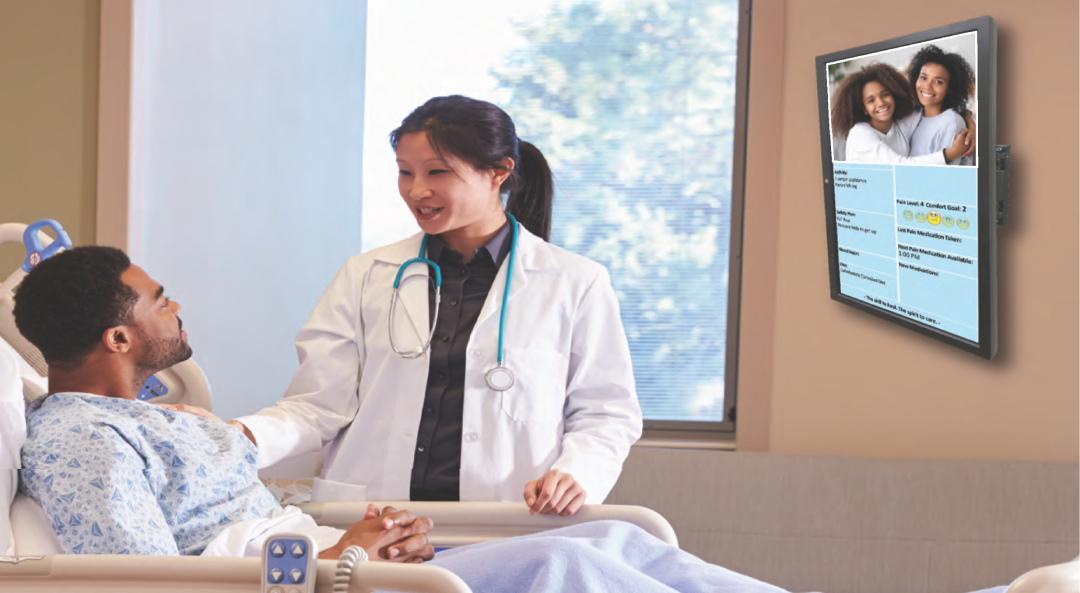As the world of healthcare continues to advance its technology and care protocols, the demand for streamlined communication — not only for nursing staff, but also patients, their families and remote care team members — has only intensified.
In fact, a 2022 study in the Journal of Patient Safety highlighted that approximately 49% of all medical malpractice claims are linked to some form of communication failure.
In a medical world reshaped by a global pandemic and its resulting challenges, do traditional dry erase boards or grease boards really meet your facility’s needs?
Why Traditional Whiteboards Fall Short
When whiteboards were first introduced to hospitals, they were primarily found in operating rooms. Here, they played a pivotal role in communicating which patients were headed to which rooms, and which medical staff was assigned to each procedure.
Their success in this environment led them to become mainstays at nursing stations and in patient rooms, proving indispensable not only for coordinating multidisciplinary rounding and keeping track of staff and care plan statuses — but also as a vital communication tool for patients to understand and engage with their care.
Yet, as healthcare and demand for nurses grew more complex, dry erase boards began to show their limitations.
A 2023 survey from the Journal of Emergency Nursing assessing perceptions of bedside whiteboards among emergency department healthcare providers revealed:
- Consistency Concerns: 85.9% of healthcare staff believe bedside whiteboards are not updated consistently.
- Shift Inconsistencies: 81.2% feel there’s inconsistency across different shifts.
- Lack of Access to Tools: 73.4% of healthcare staff claim they lack access to the necessary tools to update the whiteboards.
Misplaced or dried-out markers — coupled with the time required to update boards manually that could have otherwise been spent on bedside care — underscore a fundamental problem. Traditional whiteboards, while once a useful tool, no longer meet the evolving needs of modern healthcare.
The Power of Electronic Whiteboards
The core principle behind whiteboards, offering a transparent and visual medium for healthcare communication, remains the same.
However, electronic whiteboards like West-Com’s proprietary Patient and Unit CareBoards™ elevate this principle, introducing several key advantages:
Dynamic Display with Real-time Updates
Unlike static, traditional grease boards, electronic whiteboards display real-time patient-care information with a fraction of the hands-on expense.
This includes details such as caregiver names, patient status, room/unit information and care plans, which can be updated automatically through system integrations or manually by staff using a browser-based application. Automated updates from a patient’s electronic health record (EHR) guarantee real-time accuracy, eliminating the need for manual data input.
This streamlined process enhances clinical workflow, reduces human error and provides visibility to hospital-defined care details to both patients and caregivers at the bedside.
Unified Unit Information System
The right electronic whiteboard can provide data sets customized for each unit, such as patient/staff assignments, discharges, transfers, patient status and call activity.
These real-time dashboards display metrics like unit census, call volumes and response times so care coordination is streamlined across the unit, allowing for more efficient workflow for nursing leadership, staff and departments like EVS.
In the long run, these efficiencies can also translate to financial savings for facilities due to reduced operational costs and potential increased patient throughput.
Robust System Integrations
Electronic whiteboards are designed to integrate seamlessly with a variety of hospital information systems including ADT, EMR, EHR, RTLS, Nurse Call, Nutrition Care Management and even connectivity with wired/wireless hospital beds.
They bring together data from different sources, providing complete and coordinated patient care, so no information falls through the cracks.
Customizable Patient Experience
Advanced experiential controls, such as adjusting screen brightness or transitioning to night mode, allow nurses to tailor the electronic whiteboard’s display to best suit the patient environment.
Templates can also be adjusted based on unit demographics, supporting patient-centered care in which individual needs and comfort are always prioritized. Every patient is unique; their electronic whiteboard experience should be too.
Versatile Access & Compatibility
Electronic whiteboards can be accessed and updated from any computer equipped with a web browser, making them versatile and adaptable to various locations within the healthcare facility, such as charting stations.
Care teams can access and update patient information from anywhere. This ensures timely care and intervention that addresses patients’ needs throughout their length of stay.
Elevate Healthcare Communication with West-Com CareBoards™
The healthcare industry is always evolving, so it’s essential to stay at the forefront of change.
Facilities that adopt cohesive and dynamic platforms can revolutionize patient engagement and improve healthcare communication, enhancing the patient experience while facilitating caregiver capabilities with immediate insights.
Discover how West-Com’s CareBoard™ Electronic Whiteboards are elevating the way care teams, patients and their families communicate within healthcare environments and request a demo today.

